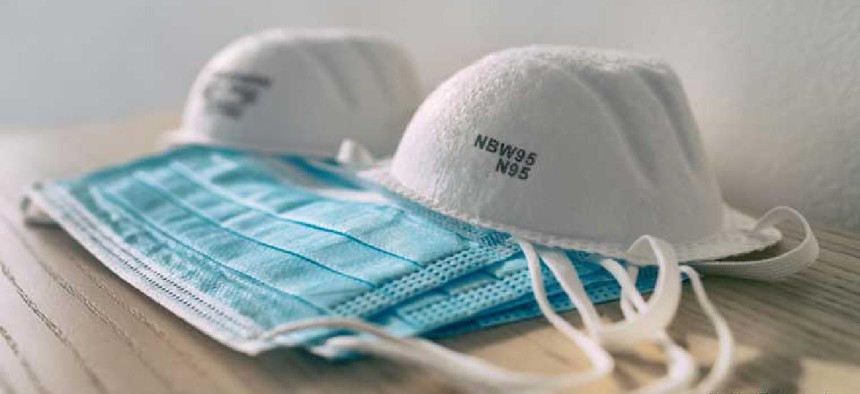Can a rice cooker disinfect an N95 mask?

From industrial decontamination units to kitchen appliances, scientists have devised ways to extend the life of N95 masks.
With the rise in the number of COVID-19 cases likely triggering a demand surge for even more personal protective equipment, scientists have devised some creative ways to safely decontaminate used masks so they can be reused. The Centers for Disease Control and Prevention cites ultraviolet germicidal irradiation, vaporous hydrogen peroxide and moist heat as the decontamination methods that have shown the most promise, but there are some DIY options.
One of the most widespread methods comes from Battelle, which offers a free vaporous hydrogen peroxide decontamination service for N95 masks worn by health care workers. Hospitals and health facilities collect, label and ship the used PPE to a decontamination center – now set up in approximately 50 cities -- using a commercial carrier such as Cardinal Health and FedEx, which provide free end-to-end logistics support to organizations enrolled in Battelle’s program.
Once the shipment arrives at the center, the masks are logged in and barcoded so Battelle can ensure a chain of custody and monitor the number of times each mask has been decontaminated. The masks are loaded into a decontamination chamber, where up 5,000 can be processed, and the chamber is flooded with an Environmental Protection Agency-registered sterilant. On completion, Battelle verifies masks are free of the virus and packages them for return.
The program is funded by a contract from the Defense Logistics Agency on behalf of the Department of Health and Human Services and the Federal Emergency Management Agency.
Sandia National Laboratories, meanwhile, is researching how to safely decontaminate and reuse respirators or masks to address shortages in critical personal protective equipment.
One study examines the impact of repeated decontamination cycles on N95 masks’ filtration, fit and mechanical integrity. Another investigates the use of supercritical carbon dioxide -- an eco-friendly solvent for dry-cleaning -- to sterilize N95 masks and other critical medical supplies for reuse. If found to be appropriate and effective, the sterilization process could be rapidly deployed at hospitals nationwide because it is already used in commercial dry cleaning, lab officials said.
A researcher at George Washington University is working on a "plasma brush" that could help decontaminate protective masks, gloves and other necessary gear for reuse.
Plasmas typically exist at extremely high temperatures, but a "cold" atmospheric plasma method, devised by medical engineering professor Michael Keidar, requires only the gas's electrons to be at an elevated temperature, making this form of plasma safe for use on and near humans. Additionally, atmospheric cold plasma differs doesn't use a liquid agent, making it safe for use on damage-prone surfaces, university officials said. The proposed "brush" system is expected to be "very fast -- you can just scan the surface one time and that's it," Keidar said.
Researchers at the University of Michigan are developing tiny wireless sensors that could verify, in real time, whether masks are being exposed to proper decontamination conditions.
While several studies have demonstrated that certain combinations of temperature and humidity can effectively decontaminate N95 masks without damaging their performance or fit, cold or dry spots in the ovens could create too much or too little intensity and make a mask unsafe for repeated use.
The batteryless sensors are designed to provide more accurate and less cumbersome monitoring during the decontamination process. To ensure the accuracy of temperature and humidity, ovens currently use many wired sensors, creating a coils of cables that are so unwieldy that they’re often removed after the unit has been initially calibrated.
This project proposes replacing this set up with small, wireless, energy-harvesting chips that can be sprinkled in each cubby hole of the decontamination units and monitored with an adjacent device. The chips can remain in place to allow ongoing monitoring of the oven’s calibration and allow for potential future features such as real-time feedback on the oven’s temperature.
For individuals looking to contaminate their own N95 masks, there are some DIY options.
Researchers studying moist heat decontamination used rice cookers or other kitchen steamers. Although they did not examine the efficacy of the mask performance after decontamination, they found “that a short cycle of steam treatment applied via a commonly used kitchen rice cooker-steamer can be very effective for decontamination of face masks and N95 respirators.” Dry heat was less effective than moist heat or microwave-generated steam for deactivating viruses. They also found “the short cycle of steam treatment was substantially more effective than ultraviolet light treatment for N95 decontamination and nearly as effective as aerosolized peracetic acid and hydrogen peroxide.”
In a similar vein, the Department of Homeland Security’s Science and Technology Directorate has posted instructions for DIY decontamination by using moist heat from a programmable multicooker, such as an Instant Pot or pressure cooker.
“Given the significance of this outbreak and importance of respiratory protection for first responders and medical professionals, we’re investigating simple, low-cost means to sanitize potentially contaminated N95 respirators,” said Dr. Lloyd Hough, lead for S&T’s Hazard Awareness and Characterization Technology Center. “We hope front line personnel who need to use them can take advantage of this approach to extend the life of their limited supply of this critical piece of PPE.”
“S&T is thinking creatively during this nationwide crisis,” said William N. Bryan, dhs senior official performing the duties of the under secretary for Science & Technology. “We understand that PPE is not always readily available and are working tirelessly to provide Americans with simple methods to extend the life of this important equipment.”
NEXT STORY: DISA plans spectrum-sharing scheduling system






